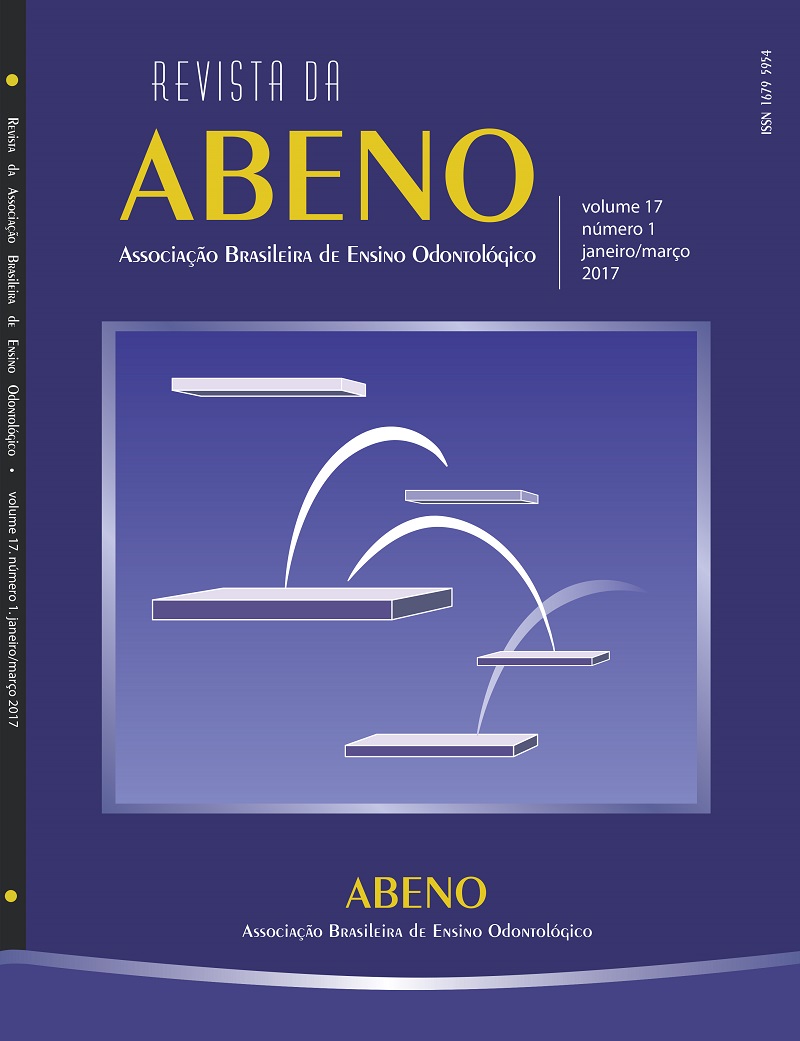Teaching and learning Oral Radiology via the social medium WhatsApp
DOI:
https://doi.org/10.30979/rev.abeno.v17i1.356Palabras clave:
Social Networking. Education. Communication. Radiology. Dentistry.Resumen
Social media can be defined as Internet-based applications that allow the widespread creation and exchange of user-generated content. The ease with which social media can be accessed through numerous mobile devices encourages medical educators to use social media to share content with students outside the classroom. The aim of this study was to introduce WhatsApp as a teaching tool in an Oral Radiology course. The secondary objective was to assess students’ attitudes towards the use of this innovative tool in teaching of dentistry. In the first semester of 2016, 30 second-year undergraduate dental students at the University of Brasília were provided with weekly quizzes via a WhatsApp discussion group. The quizzes consisted of a tomographic or radiographic image from a real clinical case and a multiple-choice question. At the end of the semester students’ attitudes were assessed using a satisfaction questionnaire. The results showed that students had a positive attitude towards the use of WhatsApp and considered it had helped them to learn about Oral Radiology. In conclusion, this technology can improve the way material is taught, since educators are prepared to develop better learning environments and students are concerned about the potential use of the social media in education.
Descargas
Citas
Kaplan A, Haenlein M. Users of the world, unite! The challenges and opportunities of social media. Bus Horizons. 2010;53:59-68.
Gupta B, Koo Y. Applications of mobile learning in higher education: An empirical study. Int J Educ Dev Using Inf Commun Technol. 2010;6(3):75-85.
Mosa A, Yoo I, Sheets L. A systematic review of healthcare applications for smartphones. BMC Med Inform Decis Mak. 2012;12:67.
Johnson L, Levine A, Smith R, Stone S. The 2010 Horizon Report. Austin, TX: The New Media Consortium; 2010.
Chickering A, Gamson Z. Seven principles for good practice in undergraduate education. American Association for Higher Education. 1987.
Michael J. Where’s the evidence that active learning works? Adv Physiol Educ. 2006; 30(4):159-67.
Crook C, Fisher T, Graber R, Harrison C, Lewin C, Cummings J, et al. Implementing Web 2.0 in secondary schools: impacts, barriers, and issues. United Kingdom: Becta; 2008. 139 p.
Cormode G, Krishnamurthy B. Key differences between Web 1.0 and Web 2.0. First Monday 2008;13(6):1-17.
Regenberg A. Tweeting science and ethics: Social media as a tool for constructive public engagement Am J Bioeth. 2010;10(5):30-1.
Khatoon B, Hill K, Walmsley A. Instant Messaging in Dental Education. J Dent Educ. 2015;79(12):1471-8.
Yeboah J, Ewur G. The impact of WhatsApp messenger usage on students performance in Tertiary Institutions in Ghana. J Educ Pract. 2014;5(6):157-64.
Nkenke E, Vairaktaris E, Bauersachs A, Eitner S, Budach A, Knipfer C, et al. Spaced education activates students in a theoretical radiological science course: a pilot study. BMC Med Educ. 2012;12(32). (cited 2016 July, 15). Available from: http://www. biomedcentral.com/1472-6920/12/32.
Makoe M. Exploring the use of MXit: A cell phone social network to facilitate learning in distance education. Open Learning 2012;25 (3):251-7.
Nicholson S. Socialization in the “Virtual Hallway”: Instant messaging in the asynchronous web-based distance education classroom Internet and Higher Education 2002;5(4):363-72.
Dewah P, Mutula S. Mobile phone access and use among students at the National University of Technology (NUST) Bulawayo, Zimbabwe: Implications for academic integrity Innovation. Journal of Appropriate Librarianship and Information Work in Southern Africa: Information Ethics 2013;46:150-65.
McCambridge J, Witton J, Elbourne DR. Systematic review of the Hawthorne effect: New concepts are needed to study research participation effects. J Clin Epidemiol. 2014; 67(3):267-77.
Gonzalez S, Gadbury-Amyot C. Using Twitter for Teaching and Learning in an Oral and Maxillofacial Radiology Course. J Dent Educ. 2016;80(2):149-55.
November A, Mull B. How Twitter can be used as a powerful educational tool Creative Commons: NovemberLearning.com; 2012 [cited 2016 July, 15].
Valachovic RW. Commission on change and innovation in dental education. ADEA Charting Progress. 2006.
Stein CD, Eisenberg ES, O'Donnell JA, Spallek H. What dental educators need to understand about emerging technologies to incorporate them effectively into the educational process. J Dent Educ. 2013;78(4):520-9.
Nielsen J. College students on the web. [Internet}. 2010 (cited 2016 Jun 28). Available from: www.nngroup.com /articles/college-students-on-the-web/.
Levy S. (Some) attention must be paid! Carrying a Black-Berry is admitting that your commitment to your current activity is only partial. Newsweek. 2006 March 27:16.
Fuchs C, Hofkirchner W, Schafranek M, Raffl C, Sandoval M, Bichler R. Theoretical foundations of the web: cognition, communication, and cooperation - towards an understanding of web 1.0, 2.0, 3.0. Future Internet 2010;2(1):41-59.
Willemse JJ, Bozalek V. Exploration of the affordances of mobile devices in integrating theory and clinical practice in an undergraduate nursing programme. Curationis 2015;38(2):Art. #1510, 10 pages.
Chretien K, Greyson S, Chretien J, Kind T. Online posting of unprofessional content by medical students. JAMA. 2009;302(12) :1309-15.
Descargas
Publicado
Cómo citar
Número
Sección
Licencia
Autores que publicam nesta revista concordam com os seguintes termos:
a) Autores mantém os direitos autorais e concedem à revista o direito de primeira publicação, com o trabalho simultaneamente licenciado sob a Licença Creative Commons Attribution que permite o compartilhamento do trabalho com reconhecimento da autoria e publicação inicial nesta revista.
b) Autores têm autorização para assumir contratos adicionais separadamente, para distribuição não-exclusiva da versão do trabalho publicada nesta revista (ex.: publicar em repositório institucional ou como capítulo de livro), com reconhecimento de autoria e publicação inicial nesta revista.
c) Autores têm permissão e são estimulados a publicar e distribuir seu trabalho online (ex.: em repositórios institucionais ou na sua página pessoal) a qualquer ponto antes ou durante o processo editorial, já que isso pode gerar alterações produtivas, bem como aumentar o impacto e a citação do trabalho publicado (Veja O Efeito do Acesso Livre).






